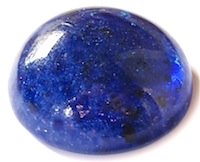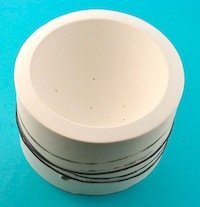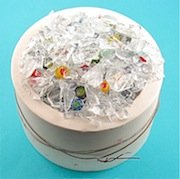Fusing A Cast Glass
Paperweight
A cast glass paperweight made in a hemispheric mold (half a ball) fired in a glass fusing kiln. It is first fused, cold worked fire polished and then annealed.

Cullet is used to minimize air bubbles that are usually present in frit casting.
To make cullet or frit - insert scrap glass between sheets of newspaper place on concrete, tap with a hammer until the pieces are reduced to the required size.
Always wear safety glasses as some fragments may escape from the paper.
The pieces are larger than coarse pieces of commercially bought frit.
Coarse frit can be used if it is easier.
The same technique is used to produce small pieces of frit or clear dichroic frit for adding to the paperweight.
If using dichroic then transparent glass will be needed for the cast paperweight so that the it can be seen. Opaque fusing colors can be used if a solid color is required.
This cast paperweight has been made with Bullseye glass.
Casting Supplies:
Cullet, transparent or opaque.
Dichroic frit.
Hemispheric fusing mold.
Kiln wash.
Prepared kiln shelf.
High temperature wire.
Diamond hand pad.
Table top grinder.
Fusing kiln.

Mold Preparation:
Apply about five coats of kiln wash evenly to the mold.
Wait for each coat to dry before adding next coat.
Ensure air holes are not blocked with wash, clean from inside with small pin. Do not remove wash from walls as material may stick to mold.
All uneven surfaces inside must be smoothed or they will be transferred to the finished item.
When dry rub finger over uneven surfaces or use very fine sandpaper to produce a smooth surface.
Remove all dust.
Wrap a few turns of high temperature wire around mold. This is a safety precaution in the unlikely event of cracking.

Filling Mold:
Fill with cullet, if using dichroic place it between layers of cullet to give a color depth to the piece.
Keep it away from the edges of the mold as it can move through other glasses during the fusing cycle.
Be careful when adding material that the wash is not scratched. Damage to the wash may result in the glass sticking.
Once filled, pile up in the center of the mold as per photo.
It will settle down as it fuses, this will be the bottom of the paperweight.
Fusing Instructions:
Sit mold on prepared shelf and place in fusing kiln.
As this is cullet, the fusing temperature can be taken up rapidly to full fuse. However, take it up at around 500 F (260 C) to about 1500 F (816 C).
Hold for fifteen minutes, or until the top is smooth and flat. This is the bottom surface of the paper weight.
Turn off kiln, do not vent kiln or open door until the kiln has cooled to room temperature. Opening the door may result in the paperweight cracking.
Cold Working:
Remove mold and set aside for twenty four hours to allow it to cool completely before removing paperweight
Small sharp needles may have developed around the top edge, which will need to be ground away with a tabletop grinder.
If wash has stuck to the glass, use a fine wet diamond hand pad to remove it.
Clean glass thoroughly.
Once clean, handle with soft cloth or gloves to prevent finger marks occurring.
Fire Polishing:
In this segment the item will be fire polished and then annealed to remove stresses from the paper weight.
Place on a prepared shelf and put in fusing kiln.
Due to its size which is 2 7/8 inches across x 1 1/8 inch thick the glass must be heated slowly to prevent thermal shock occurring.
Raise temperature by 200 F (96 C) per hour to 1100 F (593 C), hold ten minutes, continue at 200 F to around 1350 F (732 C), hold for a further ten minutes.

The weight should be nicely polished with rounded corners.
Do not over fire as the item will begin to flatten out.
Drop temperature AFAP to 900 F (482 C).
Hold at this temperature for four hours to allow annealing to be completed.
Do not open door until cooling is completed.
Allow to cool to room temperature before removing finished object.
Return From Cast Glass Paperweight To Glass Fusing Projects
Return To Home Page



